
With news that a cup of hot cocoa can prevent the onset of dementia, further studies have been completed in order to look at other health benefits.
JS Fry & Sons produced the first British chocolate bar in 1847. The Cadbury brothers produced their own version two years later and since then it has been the most popular edible indulgence. The British public not being able to get enough of the stuff, feeling guilty about eating it, then reading studies that tell us it may be wonderfully health giving after all.
SO THE TRUTH IS?
Chocolate contains more healthy plant compounds, gram for gram, than many fruit juices. Naturally containing good amounts of antioxidant super-nutrients known as flavonoids. Chocolate and cocoa that is rich in flavonoids has been shown to have anti-clotting and anti-inflammatory effects, which could lower the risk of heart disease. Flavonoids also may help to lower blood pressure as they produce nitric oxide, which helps to widen blood vessels.
Most of the research is based on people eating more than 100g of chocolate a day. The fact that the fats and sugars added to pure cocoa in order to produce more appetising chocolates such as milk and white, may cancel out the benefits.
IS CHOCOLATE AN APHRODISIAC?
One theory is that chocolate contains a mood-boosting chemical called phenylethylamine (PEA), which is also produced in the brain when a person is in love. The hormones it releases can trigger feelings of euphoria. That’s why some people eat more chocolate when they’re depressed.
A study done in 2006 explored whether women who had chocolate every day had a higher libido than those who didn’t. At first it seemed to be true but when the data was adjusted the libidos were too similar to make an accurate reading. What may be closer to the truth is that a happy woman is more compliant than an unhappy one and the way to make her happy is to shower her with chocolates.
CAN A SLAB MAKE YOU SLIM?
There has been a suggestion that it may increase your metabolism. If that were the case these benefits would cancel out the extra calories consumed?
A study conducted by the University of California proved that adults who ate the treat frequently had a lower body mass index than those who didn’t. The link was still there even when other factors, such as how much exercise people took, were taken into account.
The findings suggested that the composition of calories, not just the number of them, matters for determining their ultimate impact on weight.
DOES IT MAKE YOU CLEVER?
A researcher called Franz Messerli of Columbia University in New York took the number of Nobel Prize winners in a country as an indicator of national intelligence and correlated it with that nation’s chocolate consumption. Switzerland came top, with the highest consumption per head and also the highest number of Nobel laureates per capita. At the other end of the scale was China, which scored low on both counts.
“When you correlate the two – the consumption with the number of Nobel Prize laureates per capita – there is an incredibly close relationship,” he said.
WILL IT MAKE YOU MORE BEAUTIFUL?
Beauty treatments often use raw cocoa powder as a main ingredient in facial treatments. This comes back to those antioxidants, which reduces free-radical damage that can come from pollution such as sunburn, cigarette smoke and alcohol.
So if you’re not up for eating it every day, you can always wrap yourself in a sweet coating, to make all your blemishes disappear.




